Adhering Solid Precipitation in the Current and Pseudo-Global Warming Future Climate over the Canadian Provinces of Manitoba and Saskatchewan
Abstract
1. Introduction
2. Datasets and Methodology
2.1. Observational Meteorological and Land Surface Data
2.2. Weather Research and Forecasting (WRF) Simulations
2.3. Methodology Including Definitions
3. Model Evaluation
4. Adhering Solid Precipitation Patterns
4.1. Occurrences and Amounts
4.2. Spatial Patterns of Occurrences and Amounts
4.2.1. Occurrences
4.2.2. Amounts
4.3. Temporal Patterns
5. Events with Adhering Solid Precipitation
5.1. Number and Duration
5.2. Amount and Duration
5.3. Longest Duration Events
6. Interpretation and Related Features
6.1. Precipitation Amount Perspective
6.2. Storm Feature Perspective
6.3. Topographic Effects
7. Implications
7.1. Adhesion, Categories, and Winds within Events
7.2. Electrical Transmission Lines and Vegetation
8. Concluding Remarks
Author Contributions
Funding
Institutional Review Board Statement
Informed Consent Statement
Data Availability Statement
Acknowledgments
Conflicts of Interest
References
- Stewart, R.E.; Theriault, J.M.; Henson, W. On the characteristics of and processes producing winter precipitation types near 0 °C. Bull. Amer. Meteor. Soc. 2015, 96, 623–639. [Google Scholar] [CrossRef]
- Hanesiak, J.; Stewart, R.E.; Painchaud-Niemi, D.; Milrad, S.; Liu, G.; Vieira, M.; Theriault, J.; Cholette, M.; Ziolkowski, K.K. The severe multi-day October 2019 snow storm over southern Manitoba, Canada. Atmos. Ocean. 2022, 60, 65–87. [Google Scholar] [CrossRef]
- American Meteorological Society. Glossary. Available online: https://glossary.ametsoc.org (accessed on 15 May 2022).
- Stewart, R.E.; Crawford, R.W.; Donaldson, N.R. Precipitation characteristics within several Canadian East Coast winter storms. Atmos. Res. 1990, 25, 293–316. [Google Scholar] [CrossRef]
- Makkonen, L.; Wichura, B. Simulating wet snow loads on power line cables by a simple model. Cold Reg. Sci. Tech. 2010, 61, 73–81. [Google Scholar] [CrossRef]
- Centre for Energy Advancement through Technological Innovation (CEATI). State of the Art Report on Designing Transmission Lines for Wet Snow Accumulation (Report No. T153733-33/101). Available online: https://www.ceati.com (accessed on 1 July 2022).
- Makkonen, L. Estimation of wet snow accretion on structures. Cold Reg. Sci. Tech. 1989, 17, 83–88. [Google Scholar] [CrossRef]
- Mohammadian, B.; Sarayloo, M.; Abdelaal, A.; Raiyan, A.; Nims, D.K.; Sojoudi, H. Experimental and theoretical studies of wet snow accumulation on inclined cylindrical surfaces. Model. Simul. Eng. 2020, 2020, 9594685. [Google Scholar] [CrossRef]
- Peabody, A.; Finstad, K.; Jones, K.; Orde, C.; Renwick, R. Modeling snow and wind-on-snow loads in southern Alberta. In Proceedings of the International Workshop on Atmospheric Icing of Structure XII, Yokohama, Japan, 9–12 October 2007. [Google Scholar]
- Furukawa, Y.; Yamamoto, M.; Kuroda, T. Ellipsometric study of the transition layer on the surface of an ice crystal. J. Cryst. Growth 1987, 82, 665–677. [Google Scholar] [CrossRef]
- Lawson, R.P.; Stewart, R.E.; Angus, L.J. Observations and numerical simulations of the origin and development of very large snowflakes. J. Atmos. Sci. 1998, 55, 3209–3229. [Google Scholar] [CrossRef]
- Nygaard, B.E.K.; Ágústsson, H.; Somfalvi-Toth, K. Modeling wet snow accretion on power lines: Improvements to previous methods using 50 years of observations. J. Appl. Meteor. Climat. 2013, 52, 2189–2203. [Google Scholar] [CrossRef]
- Frick, C.; Wernli, H. A case study of high-impact wet snowfall in northwest Germany (25–27 November 2005): Observations, dynamics, and forecast performance. Weather Forecast. 2012, 27, 1217–1234. [Google Scholar] [CrossRef]
- Bonelli, P.; Lacavalla, M.; Marcacci, P.; Mariani, G.; Stella, G. Wet snow hazard for power lines: A forecast and alert system applied in Italy. Nat. Hazards Earth Syst. Sci. 2011, 11, 2419–2431. [Google Scholar] [CrossRef]
- Spiegler, D.B.; Fisher, G.E. A snowfall prediction method for the Atlantic seaboard. Mon. Weather Rev. 1971, 99, 311–325. [Google Scholar] [CrossRef]
- Kocin, P.J.; Uccellini, L.W. Snowstorms along the Northeastern Coast of the United States: 1955 to 1985; American Meteorological Society: Boston, MA, USA, 1990; p. 280. [Google Scholar] [CrossRef]
- McMurdie, L.A.; Heymsfield, G.M.; Yorks, J.E.; Braun, S.A.; Skofronick-Jackson, G.; Rauber, R.M.; Yuter, S.; Colle, B.; McFarquhar, G.M.; Poellot, M.; et al. Chasing snowstorms: The Investigation of Microphysics and Precipitation for Atlantic Coast-Threatening Snowstorms (IMPACTS) campaign. Bull. Amer. Meteor. Soc. 2022, 103, E1243–E1269. [Google Scholar] [CrossRef]
- Stewart, R.E.; Bachand, D.; Dunkley, R.R.; Giles, A.C.; Lawson, B.; Legal, L.; Miller, S.T.; Murphy, B.P.; Parker, M.N.; Paruk, B.J.; et al. Winter storms over Canada. Atmos. Ocean 1995, 33, 223–248. [Google Scholar] [CrossRef]
- Mekis, E.; Stewart, R.E.; Theriault, J.M.; Kochtubajda, B.; Bonsal, B.R.; Liu, Z. Near 0 °C surface temperature and precipitation type patterns across Canada. Hydrol. Earth Syst. Sci. 2020, 24, 1741–1761. [Google Scholar] [CrossRef]
- Isaac, G.A.; Joe, P.I.; Mailhot, J.; Bailey, M.; Belair, S.; Boudala, F.S.; Brugman, M.; Campos, E.; Carpenter, R.L.; Crawford, R.W.; et al. Science of Nowcasting Olympic Weather for Vancouver 2010 (SNOW-V10): A World Weather Research Programme project. Pure Appl. Geophys. 2014, 171, 1–24. [Google Scholar] [CrossRef]
- Janz, B. Southern Alberta’s paralyzing snowstorms in April 1967. Weatherwise 1968, 21, 70–75. [Google Scholar] [CrossRef]
- Chartrand, J.; Thériault, J.M.; Marinier, S. Freezing rain events that impacted the province of New Brunswick, Canada, and their evolution in a warmer climate. Atmos. Ocean 2022, 61, 40–56. [Google Scholar] [CrossRef]
- Bauer, D. Snow accretion on power lines. Atmosphere 1973, 11, 88–96. [Google Scholar] [CrossRef]
- Tropea, B.; Stewart, R. Assessing past and future hazardous freezing rain and wet snow events in Manitoba, Canada using a pseudo-global warming approach. Atmos. Res. 2021, 259, 105656. [Google Scholar] [CrossRef]
- Intergovernmental Panel on Climate Change (IPCC). Climate Change 2021: The Physical Science Basis. Contribution of Working Group I to the Sixth Assessment Report of the Intergovernmental Panel on Climate Change. Available online: https://www.ipcc.ch/report/ar6/wg1/ (accessed on 1 June 2022).
- Stewart, R.E.; Szeto, K.K.; Bonsal, B.R.; Hanesiak, J.M.; Kochtubajda, B.; Li, Y.; Theriault, J.M.; DeBeer, C.M.; Tam, B.Y.; Li, Z.; et al. Summary and synthesis of Changing Cold Regions Network (CCRN) research in the interior of western Canada—Part 1: Projected climate and meteorology. Hydrol. Earth Syst. Sci. 2019, 23, 3437–3455. [Google Scholar] [CrossRef]
- Ohba, M.; Sugimoto, S. Impacts of climate change on heavy wet snowfall in Japan. Clim. Dyn. 2020, 54, 3151–3164. [Google Scholar] [CrossRef]
- Nitu, R.; Roulet, Y.A.; Wolff, M.; Earle, M.; Reverdin, A.; Smith, C.; Kochendorfer, J.; Morin, S.; Rasmussen, R.; Wong., K.; et al. WMO Solid Precipitation Intercomparison Experiment (SPICE) (2012–2015); Report No. 131; World Meteorological Organization: Geneva, Switzerland, 2018. [Google Scholar]
- Liu, C.; Ikeda, K.; Rasmussen, R.; Barlage, M.; Newman, A.J.; Prein, A.F.; Chen, F.; Chen, L.; Clark, M.; Dai, A.; et al. Continental-scale convection-permitting modeling of the current and future climate of North America. Clim. Dyn. 2017, 49, 71–95. [Google Scholar] [CrossRef]
- Environment and Climate Change Canada (ECCC). Manual of Surface Weather Observation Standards, 8th Edition. Available online: http://publications.gc.ca/collections/collection_2019/eccc/En56-238-2-2018-eng.pdf (accessed on 1 May 2022).
- Environment and Climate Change Canada (ECCC). Historical Data. Available online: https://climate.weather.gc.ca/historical_data/search_historic_data_e.html (accessed on 1 May 2022).
- Smith, C.D.; Mekis, E.; Hartwell, M.; Ross, A. The hourly wind-bias adjusted precipitation data set from the Environment and Climate Change Canada automated surface observation network (2001–2019). Earth Syst. Sci. Data Discuss. 2022, 14, 5253–5265. [Google Scholar] [CrossRef]
- Environment and Climate Change Canada. Canada’s Top 10 Weather Stories. Available online: https://www.canada.ca/en/environment-climate-change/services/top-ten-weather-stories.html (accessed on 1 October 2022).
- Schär, C.; Frei, C.; Lüthi, D.; Davies, H.C. Surrogate climate-change scenarios for regional climate models. Geoph. Res. Lett. 1996, 23, 669–672. [Google Scholar] [CrossRef]
- Taylor, K.E.; Stouffer, R.J.; Meehl, G.A. An overview of CMIP5 and the experiment design. Bull. Amer. Meteor. Soc. 2012, 93, 485–498. [Google Scholar] [CrossRef]
- Rasmussen, R.; Liu, C. High resolution WRF simulations of the current and future climate of North America. In Research Data Archive at the National Center for Atmospheric Research, Computational and Information Systems Laboratory; NCAR: Boulder, CO, USA, 2017. [Google Scholar] [CrossRef]
- Thompson, G.; Eidhammer, T. A study of aerosol impacts on clouds and precipitation development in a large winter cyclone. J. Atmos. Sci. 2014, 71, 3636–3658. [Google Scholar] [CrossRef]
- Klassen, R.W. Nature, origin, and age relationships of landscape complexes in southwestern Saskatchewan. Géographie Phys. Quat. 1992, 46, 361–388. [Google Scholar] [CrossRef]
- Lang, A.H. Guide to the Geology of Riding Mountain National Park. Information; Canada: Ottawa, ON, Canada, 1974; p. 68. [Google Scholar]
- Hare, F.K.; Thomas, M.K. Climate Canada, 2nd ed.; John Wiley and Sons Canada Ltd.: Toronto, ON, Canada, 1979; p. 230. [Google Scholar]
- Natural Resources Canada (NRCan). Forest Maps. Available online: https://www.nrcan.gc.ca/maps-tools-and-publications/maps/forest-maps/16874 (accessed on 30 May 2022).
- Brandt, J.P. The extent of the North American boreal zone. Environ. Rev. 2009, 17, 101–161. [Google Scholar] [CrossRef]
- Rowe, J.S. Forest Regions of Canada; Canadian Forestry Service Publication 1300; Department of the Environment, Canadian Forestry Service: Ottawa, ON, Canada, 1972; p. 111. [Google Scholar]
- Almonte, J.; Stewart, R.E. Precipitation transition regions over the southern Canadian Cordillera during January–April 2010 and under a pseudo-global warming assumption. Hydrol. Earth Syst. Sci. 2019, 23, 3665–3682. [Google Scholar] [CrossRef]
- Mitchell, S. Precipitation Gradients across the Continental Divide in the Southern Canadian Rockies. Master’s Thesis, University of Northern British Columbia, Prince George, BC, Canada, 2022. [Google Scholar]
- Oke, T.; Hay, J. The Climate of Vancouver; BC Geographical Series No. 50; University of British Columbia: Vancouver, BC, Canada, 1998; p. 84. [Google Scholar]
- Smith, C. The relationship between monthly precipitation and elevation in the Alberta foothills during the Foothills Orographic Precipitation Experiment. In Cold Region Atmospheric and Hydrologic Studies, The Mackenzie GEWEX Experience Volume 1: Atmospheric Dynamics; Woo, H., Ed.; Springer: Berlin/Heidelberg, Germany, 2008; pp. 167–183. [Google Scholar]
- Gill, A.L.; Gallinat, A.S.; Sanders-Demott, R.; Rigden, A.J.; Gianotti, D.J.S.; Mantooth, J.A.; Templer, P.H. Changes in autumn senescence in northern hemisphere deciduous trees: A meta-analysis of autumn phenology studies. Ann. Bot. 2015, 116, 875–888. [Google Scholar] [CrossRef]
- Cavender-Bares, J.; Potts, M.; Zacharias, E.; Bazzaz, F.A. Consequences of CO2 and light interactions for leaf phenology, growth, and senescence in Quercus rubra. Glob. Change Biol. 2000, 6, 877–878. [Google Scholar] [CrossRef]
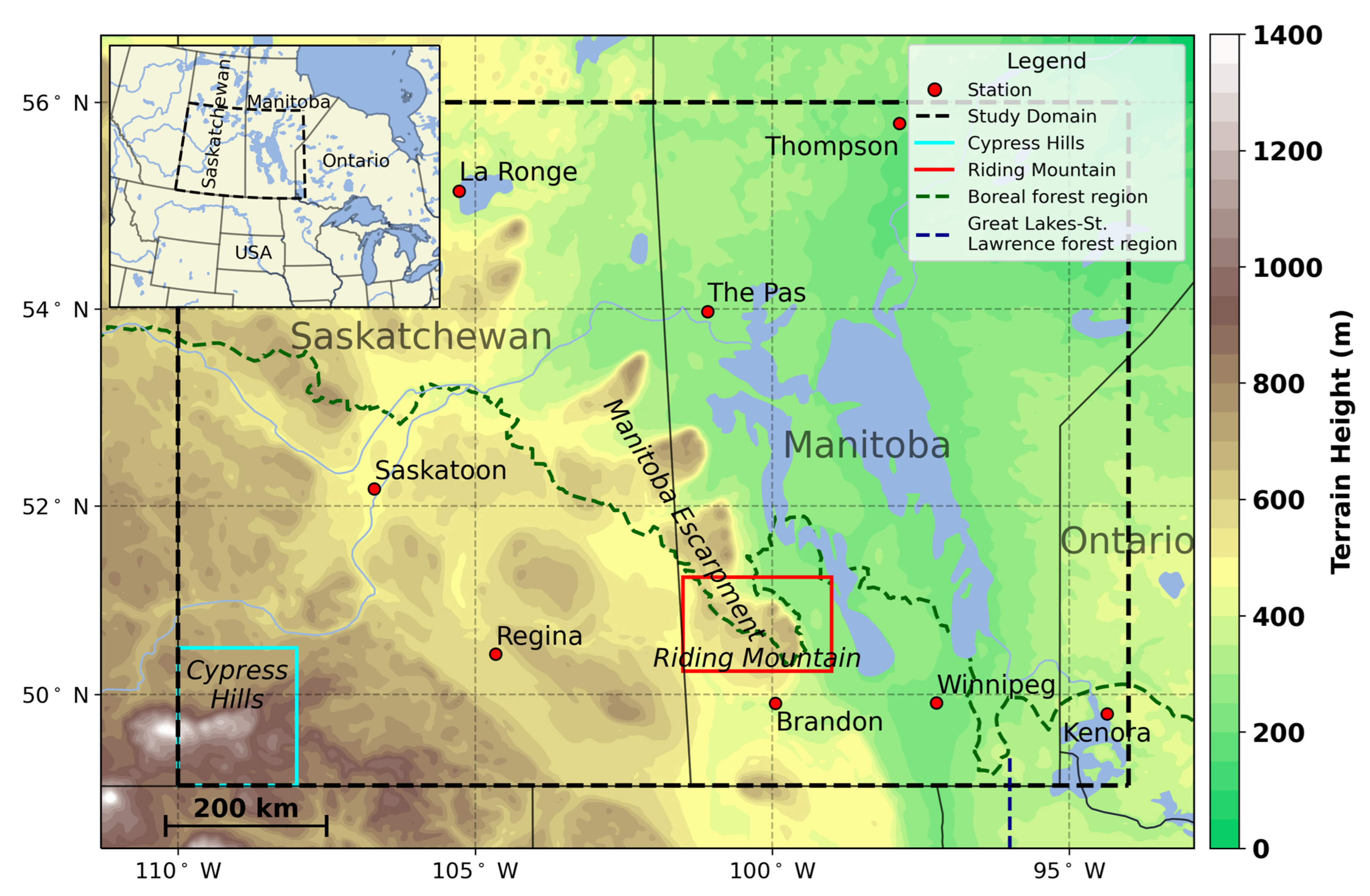
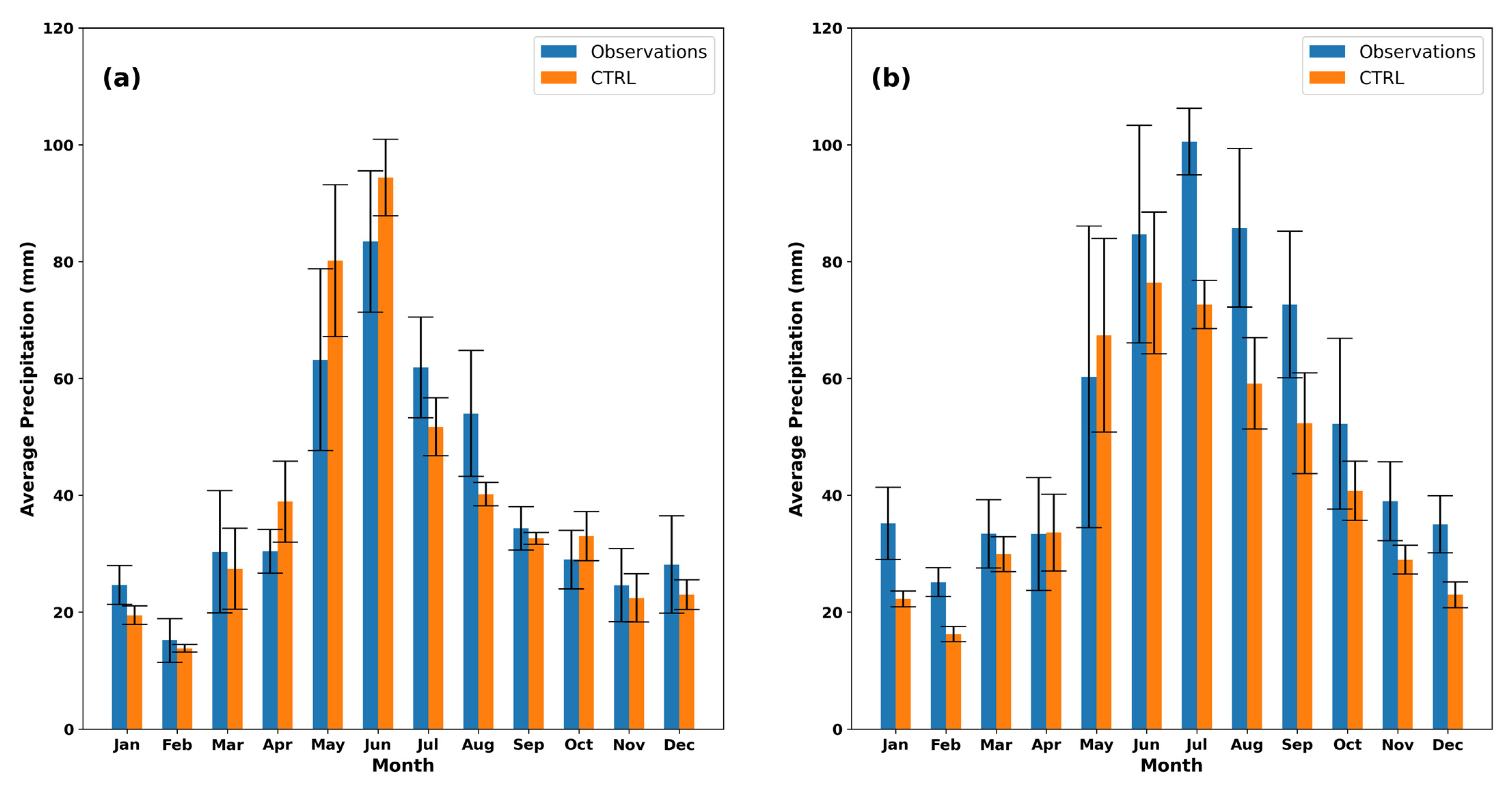


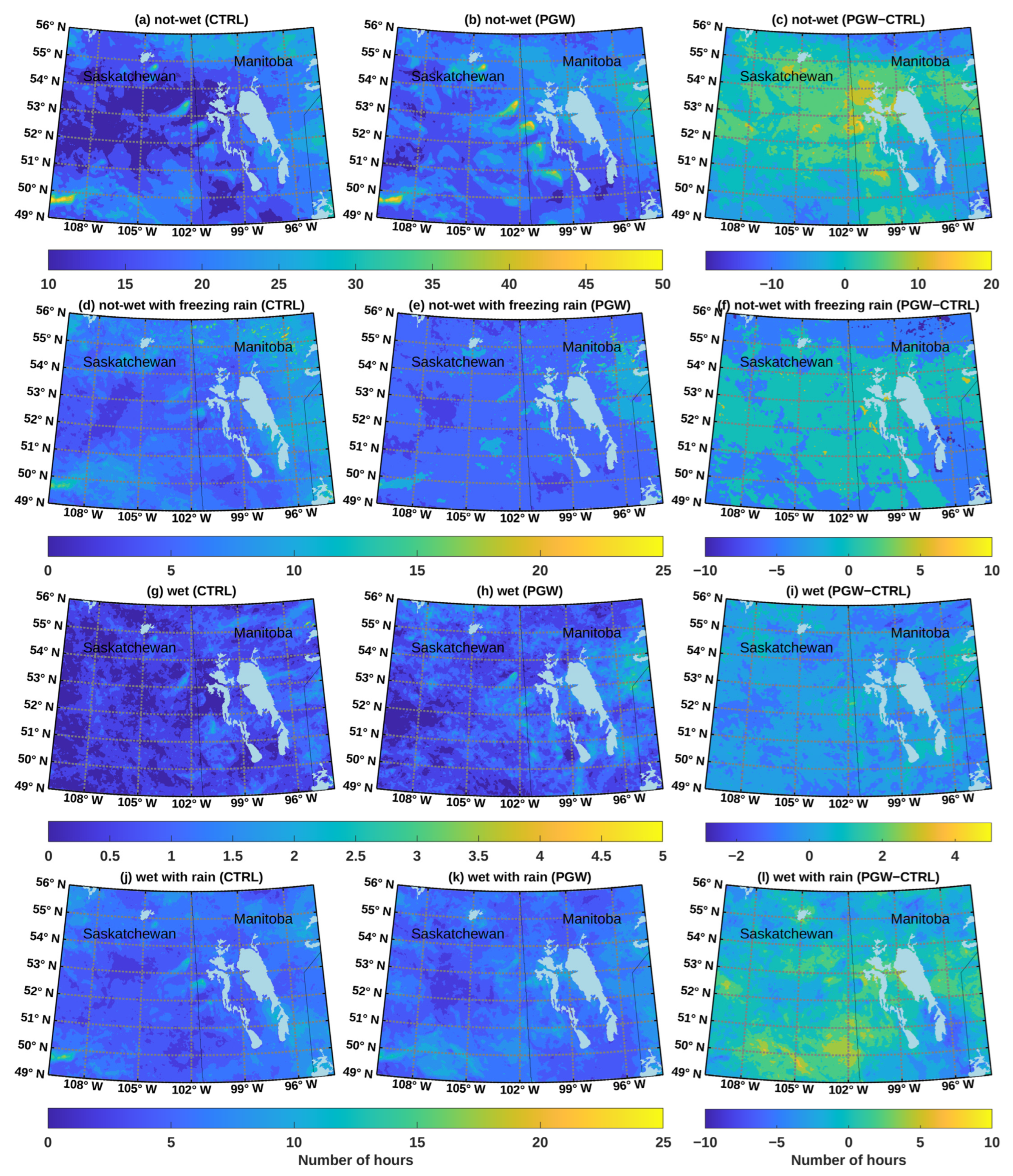

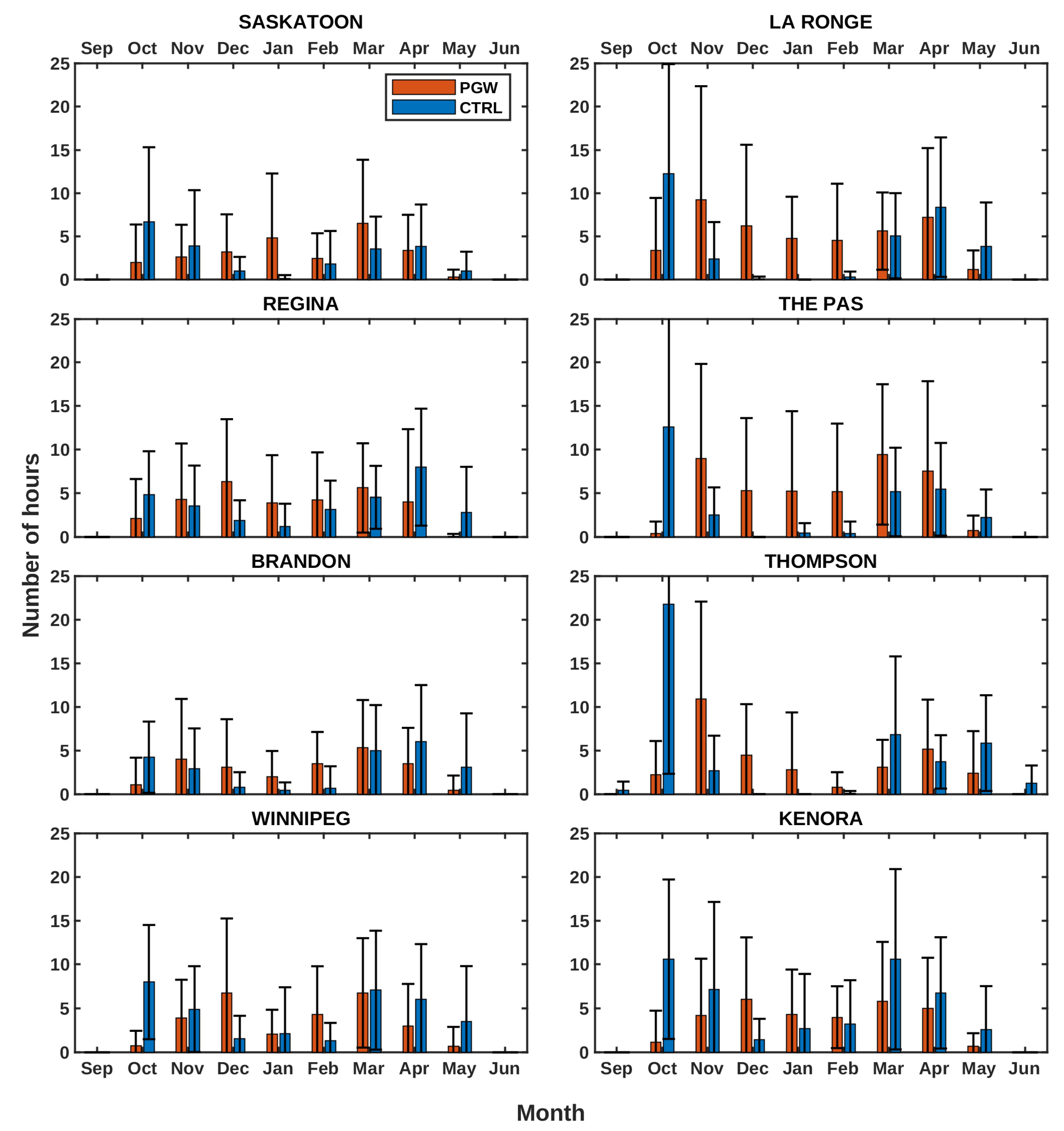

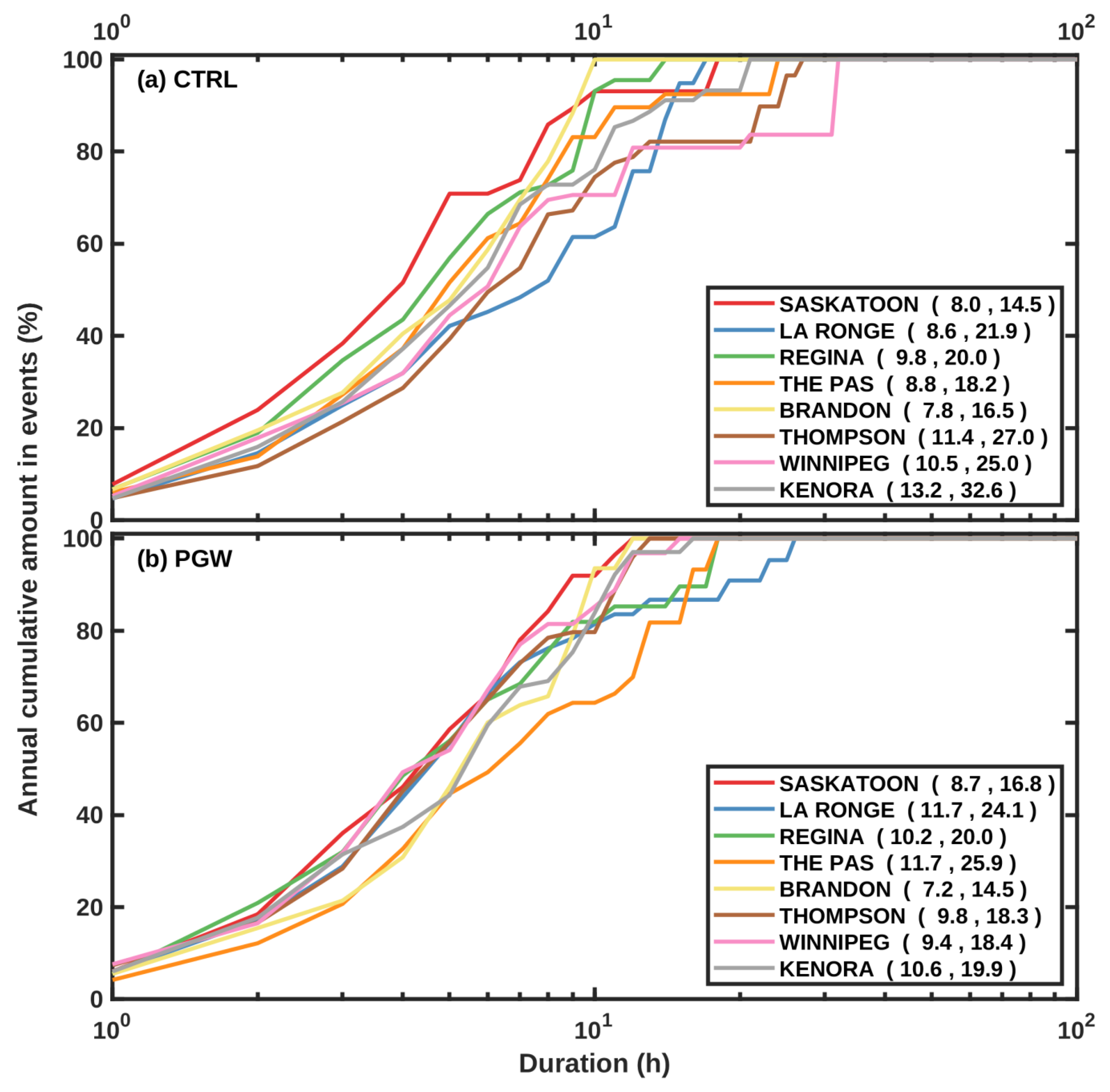
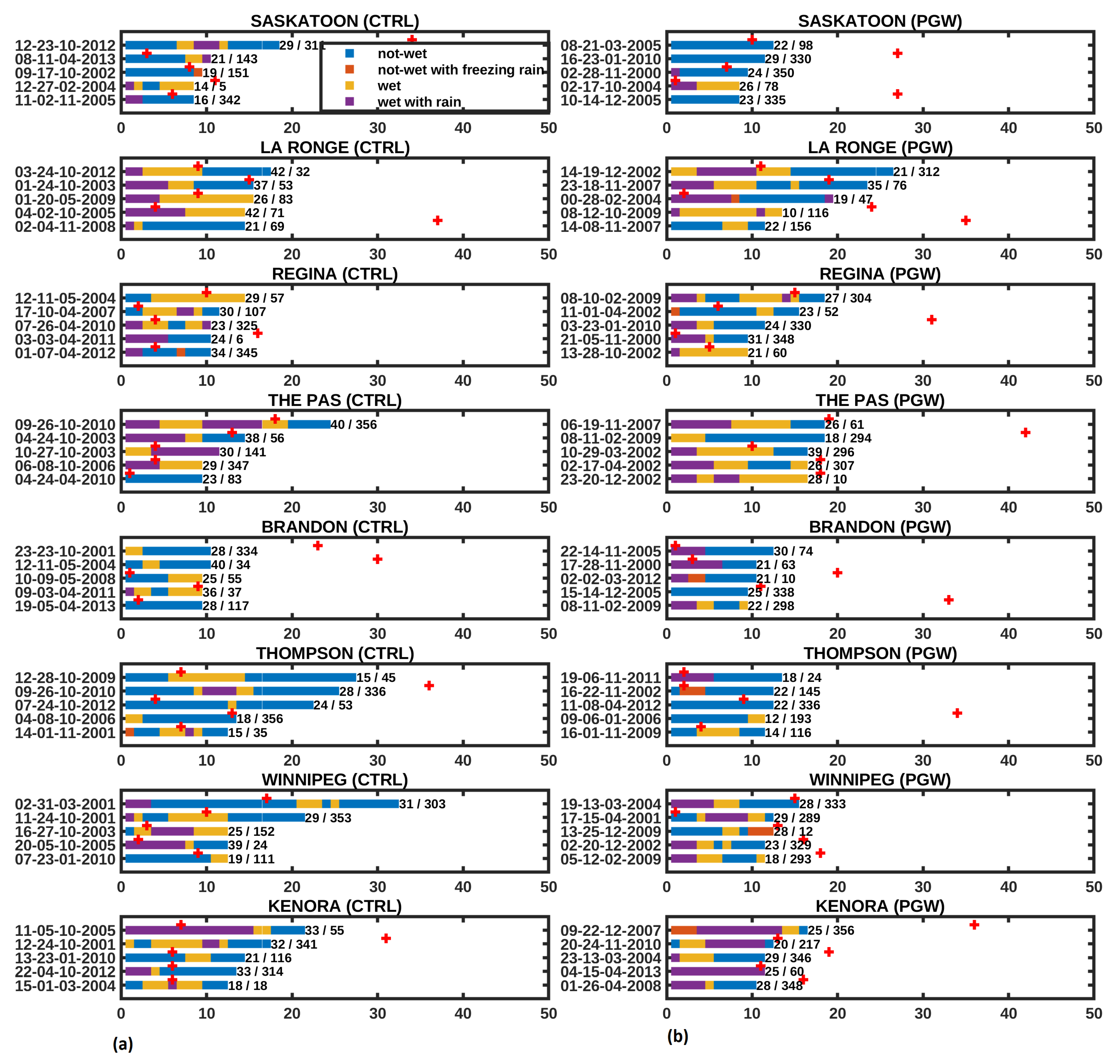
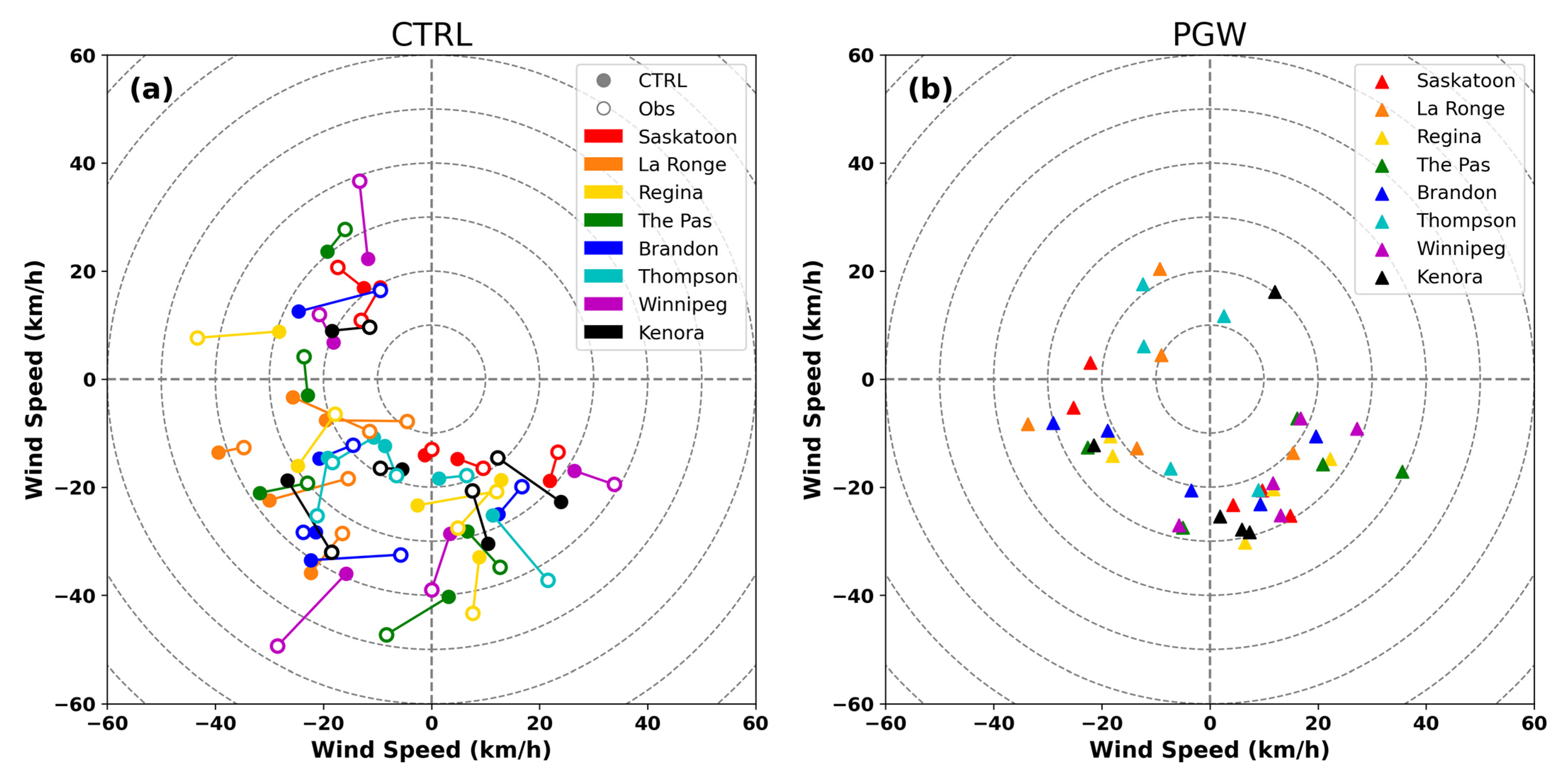
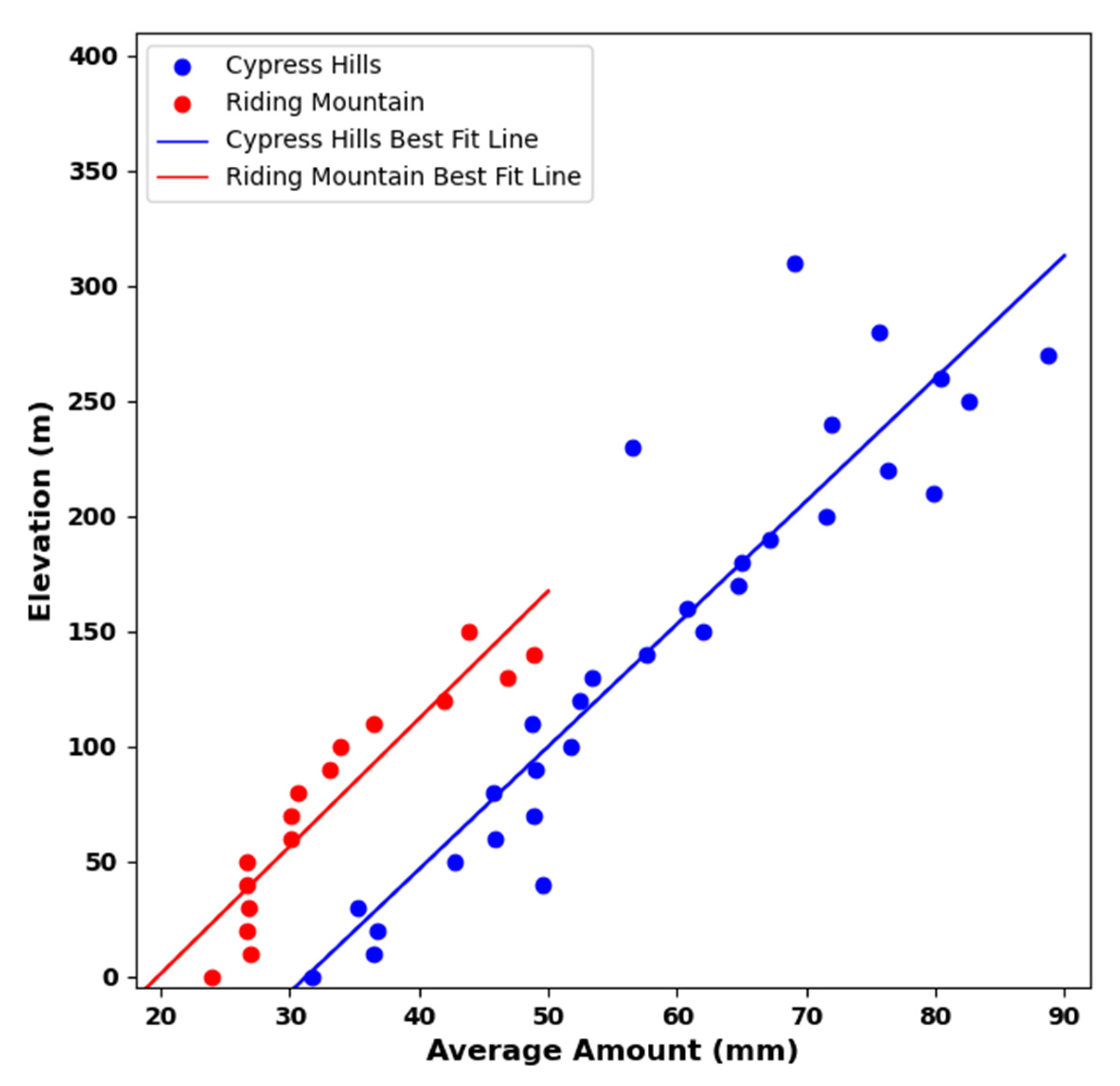
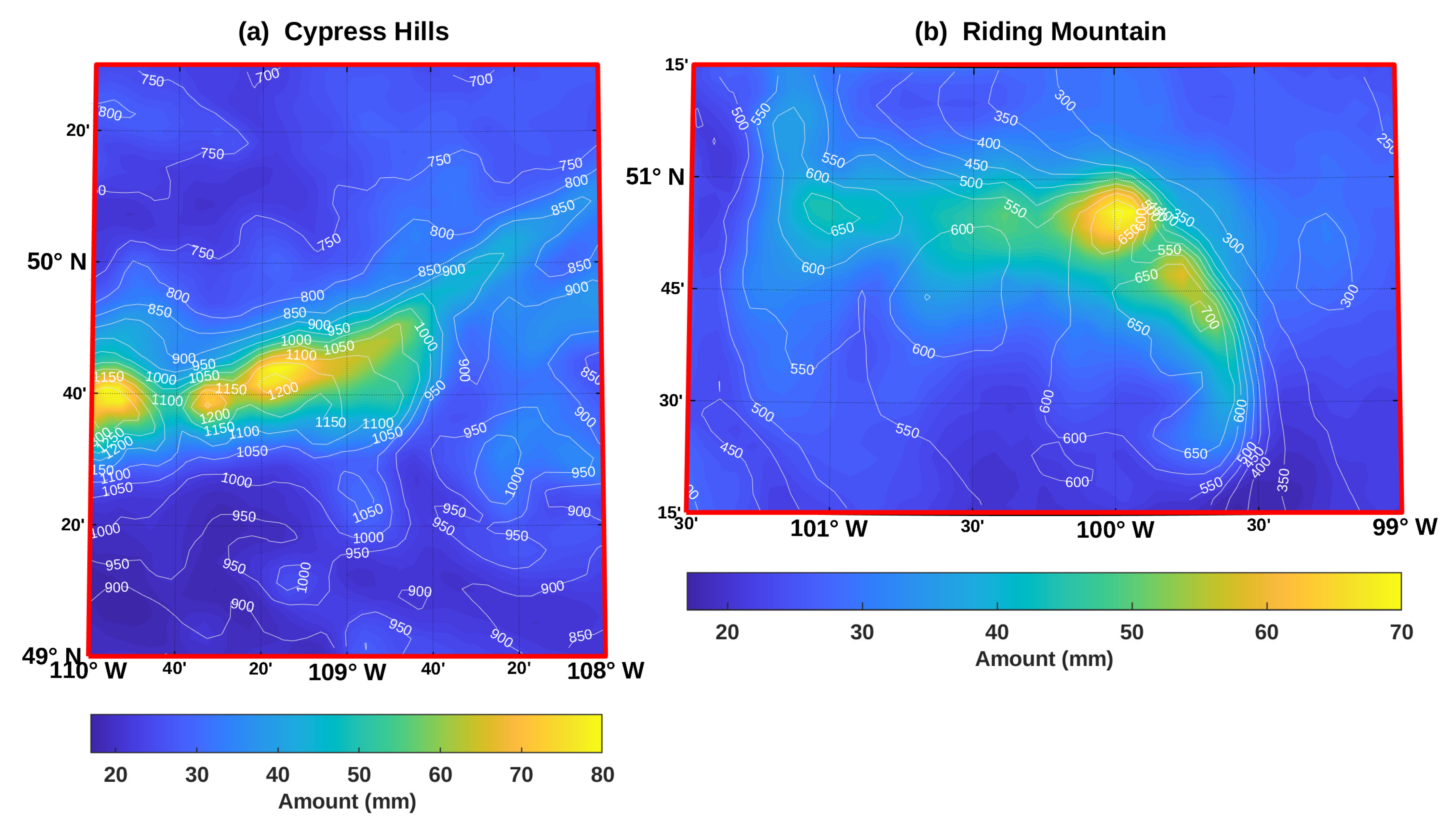
| Precipitation | Wet-Bulb Temperature |
|---|---|
| Adhering solid precipitation | −2 °C ≤ Tw ≤ 2 °C |
| Categories: | |
Solid precipitation not-wet/sticky
| −2 °C ≤ Tw ≤ 0 °C |
Solid precipitation wet/sticky
| 0 °C < Tw ≤ 2 °C |
Disclaimer/Publisher’s Note: The statements, opinions and data contained in all publications are solely those of the individual author(s) and contributor(s) and not of MDPI and/or the editor(s). MDPI and/or the editor(s) disclaim responsibility for any injury to people or property resulting from any ideas, methods, instructions or products referred to in the content. |
© 2023 by the authors. Licensee MDPI, Basel, Switzerland. This article is an open access article distributed under the terms and conditions of the Creative Commons Attribution (CC BY) license (https://creativecommons.org/licenses/by/4.0/).
Share and Cite
Stewart, R.; Liu, Z.; Painchaud-Niemi, D.; Hanesiak, J.; Thériault, J.M. Adhering Solid Precipitation in the Current and Pseudo-Global Warming Future Climate over the Canadian Provinces of Manitoba and Saskatchewan. Atmosphere 2023, 14, 396. https://doi.org/10.3390/atmos14020396
Stewart R, Liu Z, Painchaud-Niemi D, Hanesiak J, Thériault JM. Adhering Solid Precipitation in the Current and Pseudo-Global Warming Future Climate over the Canadian Provinces of Manitoba and Saskatchewan. Atmosphere. 2023; 14(2):396. https://doi.org/10.3390/atmos14020396
Chicago/Turabian StyleStewart, Ronald, Zhuo Liu, Dylan Painchaud-Niemi, John Hanesiak, and Julie M. Thériault. 2023. "Adhering Solid Precipitation in the Current and Pseudo-Global Warming Future Climate over the Canadian Provinces of Manitoba and Saskatchewan" Atmosphere 14, no. 2: 396. https://doi.org/10.3390/atmos14020396
APA StyleStewart, R., Liu, Z., Painchaud-Niemi, D., Hanesiak, J., & Thériault, J. M. (2023). Adhering Solid Precipitation in the Current and Pseudo-Global Warming Future Climate over the Canadian Provinces of Manitoba and Saskatchewan. Atmosphere, 14(2), 396. https://doi.org/10.3390/atmos14020396







